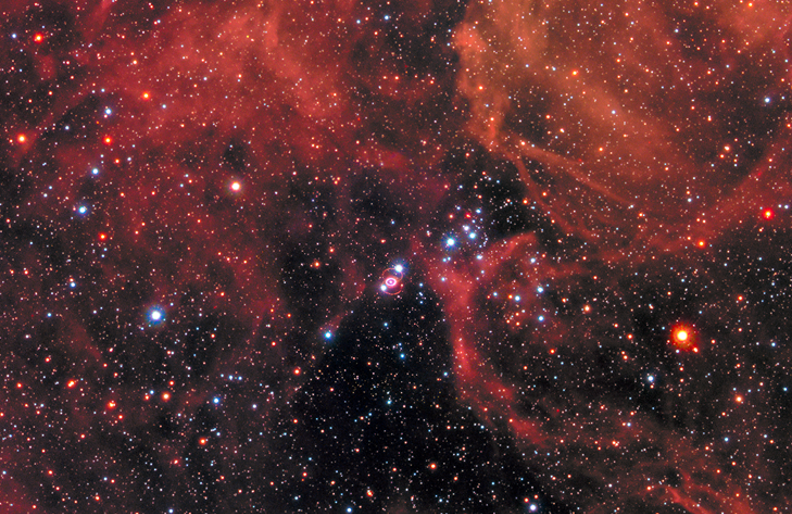It turns out these events could be even more impressive than we thought.
A supernova is the largest explosion you might ever see if you ever get to see it! It’s the death of a star, and stars go out with a bang. They’re still mostly a mystery to science. It’s possible to understand the basic processes behind them, but predicting them accurately or getting a solid understanding of the chemistry has proven difficult.
We’ve taken the first steps toward that goal though. Thanks to improvements in technology, computer models have been able to replicate what exactly happened in SN 1987A: a supernova that occurred 30 years ago. The hope is that by better understanding supernovae, we can learn about the creation of the stars and planets that fill the universe and, therefore, the development of life.
What is a Supernova?
If you are lucky enough to see a supernova, it probably occurred in a different galaxy. The Milky Way has plenty, but they’re much harder to see here thanks to the dust, gas, and other astronomical objects blocking our view. They’re still the brightest, most exhilarating explosions that occur in our galaxy. A single supernova can appear brighter than the galaxy it resides in for a period of time, making it the brightest object in the sky.
After the initial explosion, the remnant that you can see is the explosion of debris from the star. There are two ways for a star to reach this point, but both occur at the end of its lifetime.
The Death of Stars
Although here on Earth we live in a single-star system, binary star systems are common. (With another 70 times its mass, Jupiter could have been the second star in our system. Instead, it became a planet.) In a binary star system, one star often reaches the end of its life first. Instead of exploding, smaller stars like our Sun will puff up into red giants and then shed their outer layers. Eventually, the core shrinks back down and condenses into a white dwarf. Even smaller stars skip the red giant phase and burn directly down to white dwarfs.
A white dwarf has a significant gravitational pull. As its companion goes through its own red giant phase, some of the material it sheds can be pulled onto the white dwarf. As more mass gets sucked onto the white dwarf, its equilibrium gets thrown off, and it will eventually explode, creating a supernova. This is only one of two ways that supernovae form, at least that we are aware of.
For the largest stars, there is no red giant or white dwarf stage. Instead, the stars simply burn through all of their available hydrogen and are no longer able to use fusion to remain stable. This causes the inner core to collapse, and the still active matter on the outer shell of the star falls into the center, then rebounds in a supernova.
Either way, a supernova spells death for a star.
Mapping Death
While we think we have a good understanding of how supernovae form, we don’t have a good grasp of what happens inside them. This is mainly due to the fact that we’ve never been able to observe one from the inside, or even up close — which is good; you do not want to be inside one because you’d be dead. What we do know is that the largest explosions in the known universe put physics in some weird predicaments. They pop out new elements that make up everything else, including you and me. When you hear someone say that you’re made of star stuff, they aren’t making that up. The deaths of stars have given us every naturally occurring element in creation. So it’s understandable that astronomers want to find out what happens.
How were scientists able to map this supernova, exactly?
Astronomers have continued to observe the changes in a supernova observed in 1987, called SN 1987A, located in the Large Magellanic Cloud. SN 1987A is an optimal candidate to study since it’s not yet strongly affected by its surroundings.
Recently, a team from the University of Virginia used the Atacama Large Millimeter/submillimeter Array (ALMA) to study the supernova. ALMA is an array of radio telescopes designed to work together as an interferometer to process information. Astronomers chose ALMA because of its ability to see in submillimeter wavelengths. However, ALMA is susceptible to radio frequency interference. It is imperative that scientists block out all background interference since radio frequency devices are particularly susceptible to a wider variety of noise that can skew data. If its electronics weren’t protected, signals could cross and prevent discoveries. The array depends on all 66 antennas and accompanying electronics synchronizing down to a millionth of a millionth of a second. No pressure!
Because the telescopes work together at short submillimeter wavelengths, they are able to create the highest-resolution images. The inner core of SN 1987A previously eluded astronomers because gas and dust blocked out other methods of observation. ALMA’s ability to see these fine details helped astronomers finally see past the obstructions. Then, they created 3-D maps of the elements and molecules found within the collapsed supernova with the data collected. In the last 30 years, SN 1987A had time to cool down and start forming new molecules. Now we have the first results of what kinds of elements form as the result of one of these explosions.
So, what did astronomers find?
Scientists observed the formation of numerous elements, including carbon, nitrogen, and oxygen, as well as more complex molecules. These were carbon monoxide, silicon monoxide, and formylium. This leads to a whole new way to understand the physics and chemistry of supernovae. Since molecules and elements were created during this supernova, scientists may have to reevaluate their expectations for the stars.
These explosions might be capable of more than we thought.
This article was originally published by Astronomy magazine.
